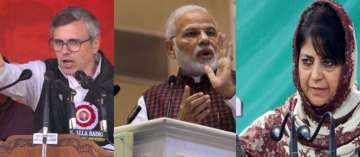J&K parties wanted Article 370 strengthened, Centre scrapped it
The Modi governments decision to scrap the relevance of Article 370 demolished the demands by Kashmir-centric parties like the National Conference and Peoples Democratic Party.

The Modi governments decision to scrap the relevance of Article 370 demolished the demands by Kashmir-centric parties like the National Conference and Peoples Democratic Party, which have been pushing for strengthening the provision of the Constitution that granted special status to the state of Jammu and Kashmir.
In fact, the step is diametrically opposite to a move by the National Conference which had got an ‘autonomy' resolution passed by the state Assembly in the year 2000 to build pressure on the Atal Bihari Vajpayee government on the issue.
National Conference was an ally in the Vajpayee-led NDA government at that time but the Centre summarily rejected it.
The Assembly resolution was based on the recommendations of the State Autonomy Committee (SAC) which wanted restoration of the pre-1953 position, when the Central government's powers, as mandated by the Article 370, were confined to defence, foreign policy and communications. Any central law to be extended to the state required endorsement by the state's Constituent Assembly.
In 1953, Sheikh Abdullah, then called ‘Wazir-e-Azam' (meaning Prime Minister), was arrested on the orders of Prime Minister Jawaharlal Nehru. In his place, Bakshi Ghulam Mohammad was appointed and then began the process of dilution of the Article 370.
While the Constituent Assembly was dissolved in 1957, a number of central laws were extended to Jammu and Kashmir. The nomenclature of the Head of the State of Jammu and Kashmir was changed from ‘Sadr-e-Riyasat' (meaning President) to ‘Governor' and that of ‘Wazir-e-Azam' to ‘Chief Minister' in 1965. The then central governments had found the route of Presidential Order to do so, the same route that the present government used.
The Autonomy resolution, pushed by National conference in 2000, said that ".…the matters agreed to by the representatives of the State and the Union vide Delhi Agreement of 1952 should continue to apply to the State, subject to the same exceptions and modifications as are specified in the said Order and the Delhi Agreement.
"All orders issued thereafter under clause (1) of Article 370 of the Constitution of India by the President, applying various provisions and matters of the Constitution of India to the State whether in full or in modified form or making any change in the provisions or matters already applied by 1950 Order or agreed to under Delhi Agreement should be rescinded and the provisions or matters so applied to the State cease to apply."
It added that "the changes made in the State Constitution vide Constitution of Jammu and Kashmir (First Amendment) Act, 1959 and Constitution of Jammu and Kashmir (Sixth Amendment) Act, 1965 be repealed and the original provisions of the Constitution of Jammu and Kashmir as adopted by the State Constitution Assembly on November 17, 1956 be restored."
Among a host of other suggestions, the SAC had also recommended that "Constitution of Jammu and Kashmir (Sixth Amendment) Act, 1965 relating to the change of nomenclature of the Head of the State and State Executive, mode of appointment of the Head of the State and other consequential amendments should be repealed and the original provisions of the constitution of Jammu and Kashmir restored." This meant restoring the nomenclatures of ‘President' and ‘Prime Minister' in the state.
Under the chapter ‘SAFEGUARDS FOR FUTURE', the SAC spoke about "the extent to which erosion was caused to the state autonomy from time to time" and said there was need "to ensure the ‘inviolability' of the final settlement" and "to keep in mind the need to maintain ‘harmonious' relations with the Centre.
"A suggestion has been made that Article 258 should be invoked for entrusting to the State ‘functions in relation to any matter to which the executive power of the Union extends'. This would put a seal on the record of the past. ‘Functions' so ‘entrusted' can always be recalled back. The issue is not one of executive ‘functions' but legislative ‘powers' apportioned the Instrument of Accession in 1947 and the Delhi Agreement of 1952 to which the President's Order of May 14, 1954 gave constitutional sanction besides, of course, Article 370 itself.
To them must we return if the popular sentiment is to be respected and resentments assuaged. It is first and foremost a moral issue. It also has important constitutional and political aspects. In the nature of things, redress can only be through another compact between the Union and the State.
"Once the basic principles are agreed, there will be a discussion on the procedure. Forty years of unconstitutional practice has created a mess. The best course is for the President to repeal all orders which are not in conformity with Constitution (Application to Jammu and Kashmir) Order, 1950 and the terms of the Delhi Agreement of 1952.
"Ever since Article 370 has acquired a dangerously ambiguous aspect. Designed to protect the State's autonomy, it has been used systematically to destroy it. A compact is necessary between the Union and the State which makes ample redress and finalizes their relationship by declaring a ‘Constitutional Understanding' that Article 370 of the Constitution of India beyond the ones extended under the new 1950 Order and the Delhi Agreement, 1952. This could be embodied in a new Article that specifies the Agreement as part of the unamendable basic structure of the Indian Constitution."
The report, as passed by the Assembly, was sent by then Chief Minister Farooq Abdullah to the Centre for acceptance but it was summarily rejected, with the BJP-led government saying the clock could not be set back.
Also Read | History, in one stroke to Patel 2.0: India's newspapers react to J&K decision
Also Read | Can J&K still be an internal matter if monitored by the UN since 1948, asks Adhir Ranjan Chowdhury
Also Read | Article 370: Closely following events in Jammu and Kashmir, says US